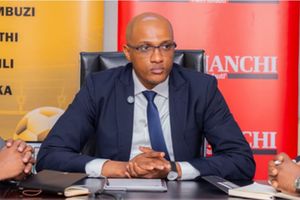Glimpse into Tanga Cement’s success in spite of big odds

The Tanga cement factory - one of the few surviving vibrant plants in the Indian Ocean coastal city which in the distant past was one of the country’s top industrial hubs.PHOTO | FILE
What you need to know:
In this interview, Business Editor Samuel Kamndaya talks with Reinhardt Swart, managing director of Tanga Cement Plc, listed among the firms that have defied the odds to stay afloat in turbulent times over the years...
The industrialisation agenda is gaining momentum with the administration of President John Magufuli seeking to steer the country towards its 2025 middle income status goal. It becomes increasingly important to learn from some of the success stories of privatisation.
In this interview, Business Editor Samuel Kamndaya talks with Reinhardt Swart, managing director of Tanga Cement Plc, listed among the firms that have defied the odds to stay afloat in turbulent times over the years...
QUESTION: Can you briefly tell us the history of Tanga Cement Plc?
ANSWER: Tanga Cement Plc is one of the country’s few privatisation success stories. The company was privatised in 1996 with 60 per cent owned by Holcim (former Holderbank, which signed a management contract in 1989) and the remaining 40 per cent by the Government of Tanzania. During that period, we produced 353,935 metric tonnes of clinker and 334,984 metric tonnes of cement per year. In 2002, the company went public with Holcim Mauritius owning a 62.5 per cent stake while 32.5 per cent of the shares were publicly traded. Five per cent was reserved for employees. The current share division stands at 68.2 per cent for AfriSam (former Holcim Mauritius) while 31.8 per cent is owned by Tanzania public institutions and individuals. Holcim Mauritius changed its name to AfriSam in line with the Black Economic Empowerment move in South Africa.
What investment has the new management made so far?
In 2010, we invested $45.75 million in a major expansion project to increase cement production capacity by adding cement mill number 2. This mill has a capacity of producing 500,000 metric tonnes of cement per year. During the same year, we commissioned a coal mill after investing a total of Sh10 billion. Then in 2013, Tanga Cement Plc broke ground for the construction of Kiln number two in a $152 million project. Construction started immediately and we expect the commissioning to be in March 2016.
We are honoured that the project has been completed within the committed timelines. This investment has had massive benefits in terms of employment creation, contribution to government revenue through taxes, and support to communities in form of corporate social responsibility.
Currently, the company directly employs 328 people in production, maintenance, quarrying, plant management, dispatch, sales and marketing, engineering and administration. We also have 363 contract workers for housekeeping, security, catering and plant operations support.
We have also invested heavily in the community in which we work. We continue to offer direct support to various community projects in the areas of education, health, community development and environment. For the past five years, from 2010 to 2014, Tanga Cement Plc gave back to the Tanzanian community more than Sh1.8 billion of which Sh834.6 million went to the education sector while health, environment and community development received Sh421.9 million, Sh201.7 million and Sh279.6 million, respectively.
What do you attribute the success of Tanga Cement to? Who are the faces behind it?
Our success story cannot be owned by a single person or group of people. The continuous and repeated successes were achieved through combined efforts of our trusted employees, dedicated managers and board of directors, our shareholders and also the communities around us.
Any particular challenges you can highlight? How are they being dealt with?
Our challenges are many. They include drastic changes in policy decisions, which affect our current investments as well as future investment decisions. Cement imports from Asia and Middle East into Tanzania, especially in our major market areas, are also giving us a lot of headaches.
The imported cement is under-declared and undervalued. Some of these imports come in with tax waivers tagged to projects but end up in the Tanzanian markets. Getting work and resident permits for expatriates, unreliable power (quality and quantity) as well as poor infrastructure also make it expensive for us to distribute our products across the country. Road is expensive and rail not functioning. Unreliable Tanga Port operations, Coal availability (quality and quantity) as well as the impact on cost of taxes, duties, levies, and royalties are making it expensive for us to operate more profitably. They account for approximately 15 per cent of the cost. Another levy of Sh1,000/tonne of coal has just been introduced by the Mbinga District Council where the local coal is found.
In a nutshell, why do some companies fail to prosper in Tanga?
The companies could be facing same problems as we do. If the above are not solved, then more companies in Tanga will not be able to survive. There are two new plants coming up in Tanga of which one has already started operations, while the other is in the construction process. We believe if the government puts its hand to resolving the above mentioned problems, then we will have a Tanga with factories that are fully operational.
What is the way forward, that is, the role of business, government and individuals?
Most countries in the world develop better when the private sector or business and government have a mutually beneficial relationship. Each of these parties has to play their roles. Businesses have to fulfil their roles of paying taxes, duties, providing employment and most important, producing products of the required quality. On the other hand, the government should support the growth of business by putting in place favourable policies as well as a level playing field for both local and foreign businesses. Individuals must support their local industries by buying locally-produced products.




